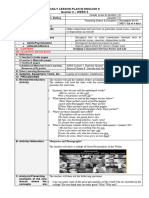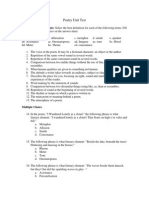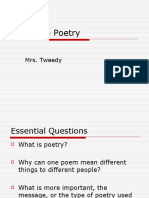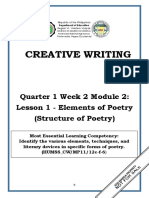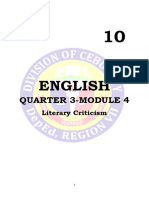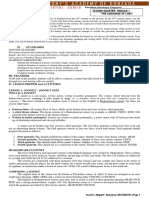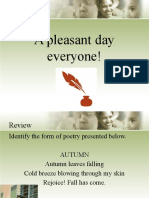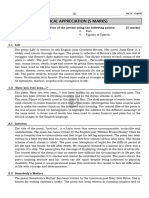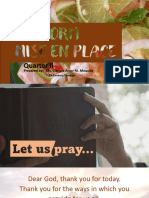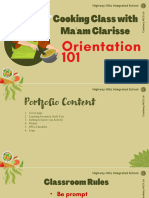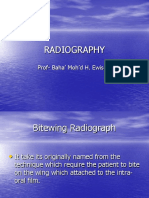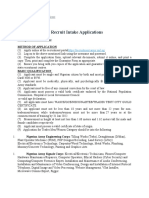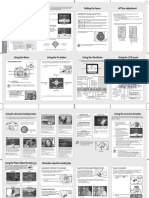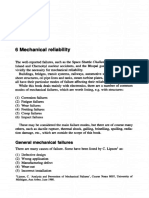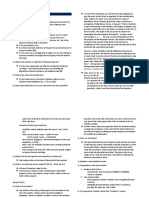PROJECT CLAID (Contextualized and Localized Activities Intended for Distance Learning)
Name :______________________________ Date: ____________ Score:________
ENGLISH 9
Quarter 2 – Week – 3
Competency: Identify the distinguishing features of notable
Anglo-American lyric poetry, songs, poems, sermons, and
allegories
Lesson: Elements and features of Anglo-American poetry
Objective/s:
1. Distinguish the different features and elements of poetry.
2. Analyze the structure of a poem.
3. Appreciate poetry as a means of expressing one’s thoughts and
feelings.
4. Compose a sonnet.
CONCEPT
1. Poetry is a literary work that is associated with the expression of
feelings and ideas.
2. Some of the elements of poetry are the following: sensory imagery,
figures of speech, lines and stanza, theme, rhyme, and meter.
ACTIVITY NO.1
Getting Started
Before you start your journey, let’s check what you already know.
A. Read the poem below and answer the questions that follow.
Adieu, farewell, earth's bliss; 1
This world uncertain is; 2
Fond are life's lustful joys; 3
1st Stanza
Death proves them all but toys; 4
None from his darts can fly; 5
I am sick, I must die. 6
Lord, have mercy on us! 7
_________________________________________________________________________
1
Q2 Week No.1 Competency Code:
Competency:
� Rich men, trust not in wealth, 8
Gold cannot buy you health; 9
2nd Stanza
Physic himself must fade. 10
All things to end are made, 11
The plague full swift goes by; 14
I am sick, I must die. 13
Lord, have mercy on us! 14
- A Litany in Time of Plague
By. Thomas Nashe
1. What literary device is used in the fourth line?
a. simile b. personification c. hyperbole d. alliteration
2. What is the rhyme scheme of the first four lines?
a. ABCD b. ABAB c. AABB d. ABBA
3. What sensory image is used in 10th line?
a. auditory b. tactile c. gustatory d. visual
4. What is the theme of the poem?
a. Inevitable death c. Preciousness of life
b. Importance of health d. Mercy of God
5. What is the tone of the poem?
a. confused b. thankful c. gloomy d. regretful
6. Which line in the poem shows that money cannot keep man from
dying?
a. Stanza 1, Line 3 and 4 c. Stanza 1, Line 1 and 2
b. Stanza 2, Line 8 and 9 d. Stanza 2, Line 13 and 14
B. Fill in the blanks with the correct word to complete the analogy.
Choose your answer from the box below.
Gustatory Sonnet Onomatopoeia Theme
7. Fragrant : Olfactory :: Sweet : ____________
8. Prose : Short Story :: Poetry : ____________
9. Red as roses: Simile :: Buzzing bees : ___________
10. Lamenting : Mood :: Self-respect : ___________
_________________________________________________________________________
2
Q2 Week No.1 Competency Code:
Competency:
� C. Let’s Review
This time let’s look back on the form of poetry you took up last
year. Do you remember Haiku? A haiku is a traditional Japanese poem
of seventeen syllables in three lines of five seven and five. It generally
evokes images of the natural world.
Directions: Compose your own haiku. Remember to follow the structure
given below.
“Color of Hope” ________________
_______________________________
Splash of great color (5 syls)
A rainbow after the rain (7 syls) _______________________________
Thy hope to honor (5 syls) _______________________________
D. Introduction
Do you love listening to music? Do you know that all songs can
be considered as poetry? Let’s try this activity to find out.
Directions: Work with your parent/guardian, sibling, friend, or relative.
Choose one among the following people mentioned above and ask
him/her the following questions:
Question Answer
1. What is your most
favorite song?
2. Which lyrics or part do
you like the most?
(write down the lyrics)
3. Why do you like this
song?
What can you notice from the song lyrics he/she has chosen? Do
the lyrics express the feelings/emotion of that person?
_________________________________________________________________________
3
Q2 Week No.1 Competency Code:
Competency:
� Discussion
Poetry is an art of rhythmical composition, which is associated
with the expression of feelings and ideas. It has different forms and
features. Let’s study the chart below:
Poetry
Forms Elements
Rhyme and Tone and
1. Lyric Poetry Lines and Meter Theme
2. Narrative Poetry. Stanza
Rhyme describes
3. Descriptive Poetry Tone is the
the word that has
A line is a author’s
the same ending
single row of feelings
sounds.
lines in a toward the
poem. poem.
Meter is the
number of syllables
A stanza is Theme is the
Lyric poetry refers to a per line with
group of lines truth, lesson,
short poem, often with designated
or message
in a poem stressed and
songlike qualities, that about life
expresses the speaker’s unstressed pattern
personal emotions and
feelings.
The most
popular form of lyric Sensory Image Figures of Speech
poetry in the Western 1.Simile- comparing two
Sensory details
tradition is the sonnet. different objects using
describe what can be
seen, heard, smelled, “like” or “as”
tasted, and felt
2.Metaphor- shows
through an author’s
comparison that is not
writing. stated but implied.
A sonnet is a
3.Personification- giving
one-stanza, 14-line human qualities to
1. Auditory (sound)
poem, written in iambic inanimate things.
2. Visual (sight)
pentameter.
3. Olfactory (smell)
The simplest 4.Onomatopoeia- a word
4. Gustatory (taste)
and most common that imitates the sound
5. Tactile (touch) it represents.
sonnet is the English
Sonnet. Its rhyme
scheme is ABAB / 5.Alliteration- the use of
the same letter at the
CDCD / EFEF / GG.
beginning of connected
words.
_________________________________________________________________________
4
Q2 Week No.1 Competency Code:
Competency:
� ACTIVITY NO.2
Getting it Right
A. Reach each sentence carefully. Identify the sensory image and figure of
speech used in each statement. Write your answer on the table provided
below.
Statement Sensory Image Figure of Speech
1. Sally’s savory sweet
and sour stew.
2. The strong scent of
durian flies all over the
room.
3. Inka’s charming voice
keeps ringing on my
head.
4. The white sand in
Manila Bay feels like
Boracay in the city.
5. His word is a sharp
arrow to my heel.
B. This time let’s try to identify the features of the poem below.
Directions: Read the sonnet carefully. Complete the checklist, unlock the
scheme and answer the questions below.
Sonnet 18
By William Shakespeare
1
Shall I compare thee to a summer’s day?
2
Thou art more lovely and more temperate:
3
Rough winds do shake the darling buds of May,
4
And summer’s lease hath all too short a date;
5
Sometime too hot the eye of heaven shines,
And often is his gold complexion dimmed, 6
And every fair from fair sometime declines, 7
By chance or nature’s changing course untrimmed; 8
But thy eternal summer shall not fade, 9
Nor lose possession of that fair thou ow’st; 10
Nor shall death brag thou wander’st in his shade, 11
When in eternal lines to time thou grow’st: 12
So long as men can breathe or eyes can see, 13
So long lives this, and this gives life to thee. 14
_________________________________________________________________________
5
Q2 Week No.1 Competency Code:
Competency:
� Checklist
Direction: Put a check the item of your answer.
List Choices
1. Number of stanzas
1 2 3 4
2. Number of lines
12 13 14 15
3. Syllables per line
9 10 11 12
4. Tone of the poem
Witty Irate Endearing Solemn
5. Theme of the poem
Charm Enmity Care Love
Unlock the Scheme
Directions: Complete the rhyme scheme of the poem. On the 2nd column
write down the last word in each line. On the 3rd column label the line
that rhymes. Write A for the first 2 words that rhyme and B for the 2 nd
set of words on so on. The first set of rhyme is done for you.
Line number Rhyme Word Label
Line 1 day A
Line 2
Line 3 May A
Line 4
Line 5
Line 6
Line 7
Line 8
Line 9
Line 10
Line 11
Line 12
Line 13
Line 14
_________________________________________________________________________
6
Q2 Week No.1 Competency Code:
Competency:
� Question and Answer
Directions: Read each question carefully. Write down your answer on
the space provided for you.
1. What figure of speech is used in line 11?
_______________________________________________________________
2. What are the two things being compared in the first line of the
poem?
_______________________________________________________________
3. What is the author’s message on the last two lines of the poem?
_______________________________________________________________
_______________________________________________________________
ACTIVITY NO.3
Sparking
A. I Can DO It!
Directions: Compose your own sonnet. Take note of the following
elements in writing your poem.
Stanza and Line: 1 stanza, 14 lines
Meter: Each line must have 10 syllables
Rhyme Scheme: ABAB - CDCD - EFEF - GG.
Topic: The Current Pandemic/ COVID 19
Title: You may create your own title for your sonnet
Must Contain: Sensory Image and Figures of Speech
_________________________________________________________________________
7
Q2 Week No.1 Competency Code:
Competency:
� B. My Discovery
Let us reflect on the things we have learned from this lesson.
Write down your answer on the space provided for you.
What did I discover about poetry?
What do I know? How can poetry be a
useful tool for me?
C. Post-test
True or False
Directions: Identify whether the following statement is true or false.
Write T if the statement is true. If the statement is false, write F and
underline the word/s that makes the statement incorrect.
__________1. A lyric poem has 14 lines and one stanza.
__________2. Poetry originated from songs and rituals.
__________3. Mood is the author’s feelings toward the poem.
__________4. Poets use figures of speech to express their ideas in a more
creative way.
__________5. We can measure the meter of a poem through the rhythm
of stressed and unstressed syllabic pattern of each line.
When I consider how my light is spent,
Ere half my days, in this dark world and wide,
And that one Talent which is death to hide
Lodged with me useless, though my Soul more bent
To serve therewith my Maker, and present
My true account, lest he returning chide;
“Doth God exact day-labour, light denied?”
I fondly ask. But patience, to prevent
On His Blindness
By John Milton
Directions: Read the poem and answer the questions that follow. Write the
letter of your answer on the space provided before each number.
_____6. What figure of speech is used in the second line?
a. Simile b. Personification c. Hyperbole d. Alliteration
_____7. What is the tone of the poem?
a. Frustrated b. Thankful c. Gloomy d. Hopeful
_____8. What is the rhyme scheme of the first four lines?
a. ABCD b. ABAB c. AABB d. ABBA
_____9. In the first line of the poem, what is symbolized by the word “light”?
a. Life b. Sight c. Talent d. Love
_____10. What is the sensory image used in the 3 line of the poem?
rd
a. Auditory b. Tactile c. Visual d. Gustatory
_________________________________________________________________________
8
Q2 Week No.1 Competency Code:
Competency:
�REFERENCES:
https://poets.org/poem/litany-time-plague
https://poets.org/glossary/lyric-poetry
https://www.newworldencyclopedia.org/entry/Lyric_poetry
https://www.thoughtco.com/what-is-a-sonnet-
2985266#:~:text=A%20sonnet%20is%20a%20one,%2C%22%20says%20Poets.org.
https://www.tes.com/lessons/VUAWs1phJy-RKA/the-elements-of-poetry
http://www.shakespeares-sonnets.com/sonnet/18
https://www.poetryfoundation.org/poems/44750/sonnet-19-when-i-consider-
how-my-light-is-spent
Hernandez, C.P. (2012) MSA Comprehensive English. Quezon City, MSA Publishing
House
Prepared by:
CHATIE B. MADDALORA
Eulogio Rodriguez Integrated School
SDO Mandaluyong
Editors:
ESPERANZA RAMOS-STARKS ADRIAN C. HERNANDEZ
Master Teacher II, MPNAG Head Teacher I, IBIS
Content Language
Approved:
RAMON M. BELARDO JR.
Education Program Supervisor, English
_________________________________________________________________________
9
Q2 Week No.1 Competency Code:
Competency:


